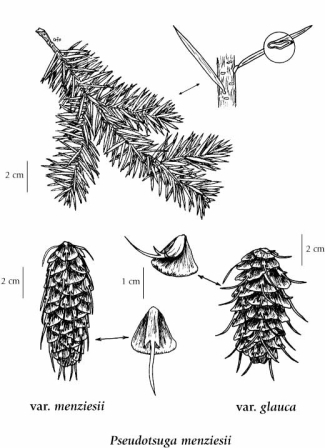Pseudotsuga menziesii (Mirb.) Franco
Douglas-fir
Pinaceae (Pine family)
Introduction to Vascular Plants
Douglas-fir
Pinaceae (Pine family)
Introduction to Vascular Plants
Photograph click to collapse contents
© David Blevins (Photo ID #468)
Photo details
View all photos for this taxon.
Introduction click to expand contents
This is a tall evergreen coniferous species of tree that is common in British Columbia.
|
Species Information click to expand contents
General:
Tree up to 70 (occasionally to 90) m tall; rounded to flattened crown when older, young trees with pyramidal crown; bark very thick, rough, dark brown.
Leaves:
Needles (1.5) 2-3 (3.5) cm long, spreading around twig or turned upward, obtuse to abruptly sharp-pointed tip; color varies from yellow-green to dark-green in var. menziesii to blue-green in var. glauca, lower surface with two longitudinal bands of white stomata.
Cones:
Seed cones drooping, yellowish- to purplish-green when young, turning reddish-brown, soon deciduous; 6-10 cm long in var. menziesii, 4-7 cm in var. glauca; scales with 3-lobed tip, the centre one the longest; pollen cones yellow to reddish, 6-10 mm long.
Notes:
Two varieties are recognized in BC:
1. Cones mostly 6-10 cm long, the bracts straight and appressed toward the cone tip; leaves deep (yellowish) green; primarily coastal.................. var. menziesii (coast Douglas-fir)
1. Cones mostly 4-7 cm long, the bracts appressed to spreading or reflexed; leaves more bluish-green; primarily interior................. var. glauca (Beissn.) Franco (Rocky Mountain Douglas-fir)
Illustration click to expand contents

If more than one illustration is available for a species (e.g., separate illustrations were provided for two subspecies) then links to the separate images will be provided below. Note that individual subspecies or varietal illustrations are not always available.
Illustration Source: The Illustrated Flora of British Columbia
USDA Species Characteristics click to expand contents
Blooming Period:
Mid Spring
Fruit/Seed characteristics:
Colour: Brown
Present from Summer to Fall
Source: The USDA
Ecology click to expand contents
Ecological Framework for Pseudotsuga menziesii
The table below shows the species-specific information calculated from
original data (BEC database) provided by the BC Ministry of Forests and Range.
(Updated August, 2013)
The table below shows the species-specific information calculated from
original data (BEC database) provided by the BC Ministry of Forests and Range.
(Updated August, 2013)
| Site Information |
Value / Class |
||
|
Avg |
Min |
Max |
|
| Elevation
(metres) |
917 | 0 | 2400 |
| Slope
Gradient (%) |
29 | 0 | 240 |
|
Aspect (degrees) |
197 | 0 | 360 |
| Soil
Moisture Regime (SMR) [0 - very xeric; 4 - mesic; 8 - hydric] |
3 | 0 | 8 |
| Modal
Nutrient Regime
Class |
C | ||
| #
of field plots species was recorded in: |
11160 | ||
| Modal
BEC Zone Class |
IDF | ||
|
All BEC Zones (# of stations/zone) species was recorded in |
BG(175), CDF(220), CWH(1615), ESSF(458), ICH(2813), IDF(3022), MH(14), MS(1237), PP(375), SBPS(65), SBS(814) | ||
|
Source:
Klinkenberg 2013
|
|||
Habitat and Range click to expand contents
Moist to dry slopes, river terraces and flats in the lowland and montane zones; common in S BC, infrequent northward to C BC; E to SW AB and S to CA and MX.
Synonyms click to expand contents
Synonyms and Alternate Names:
Pseudotsuga mucronata (Raf.) Sudw.